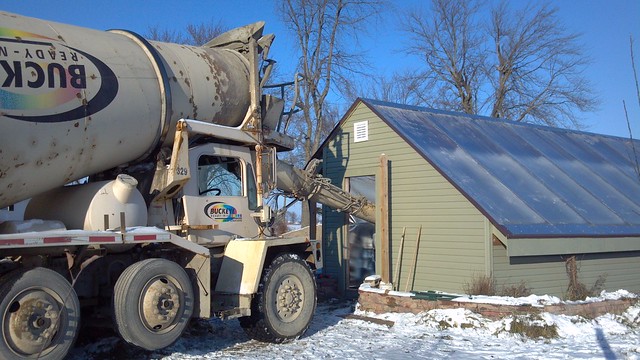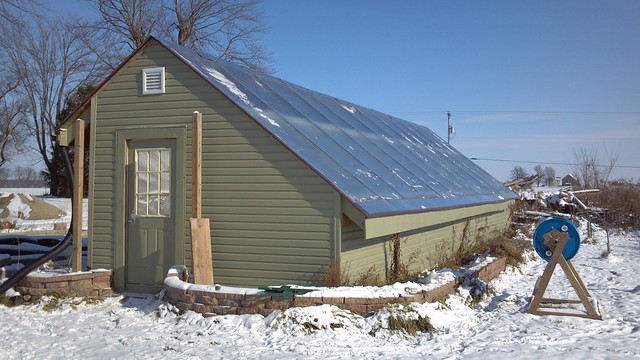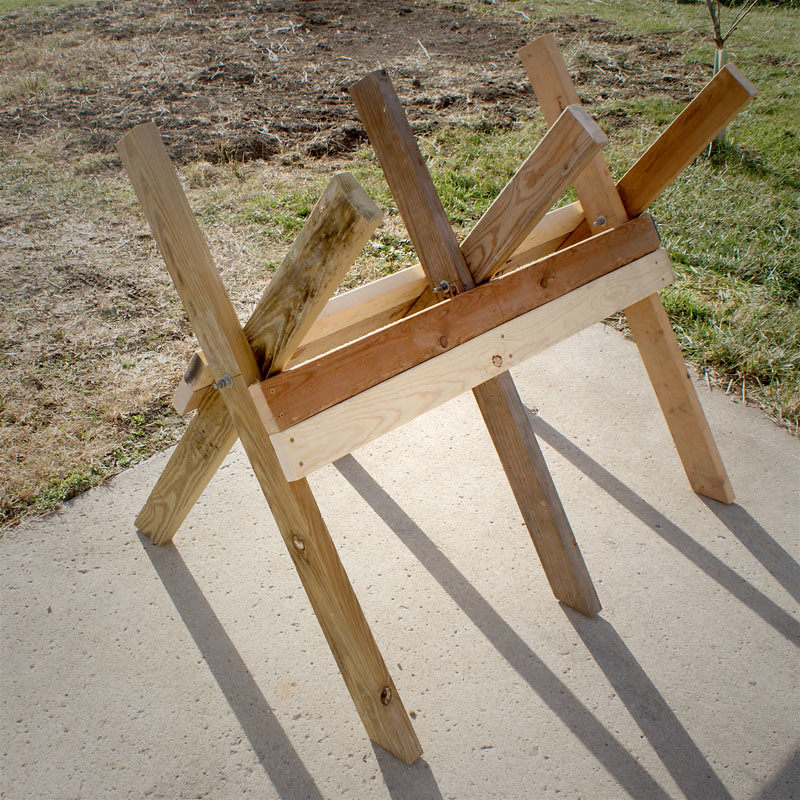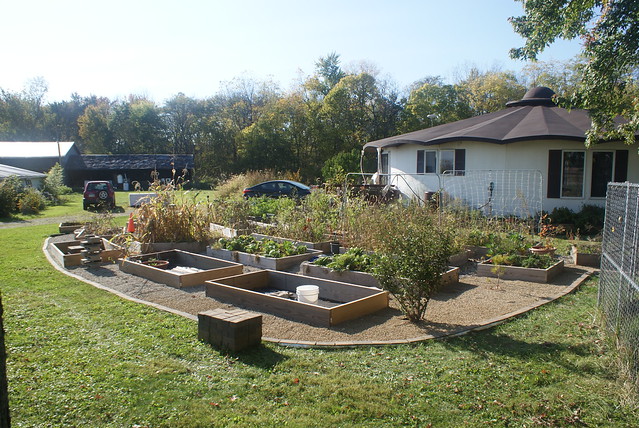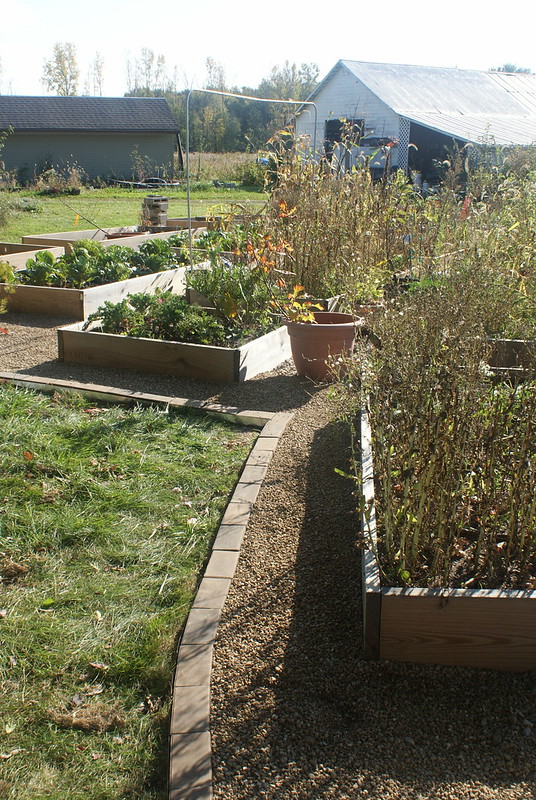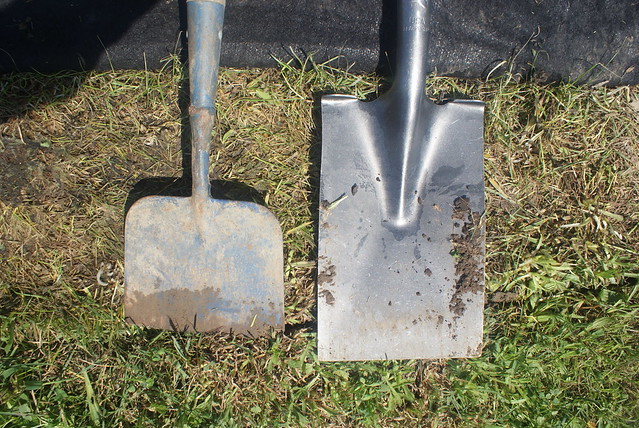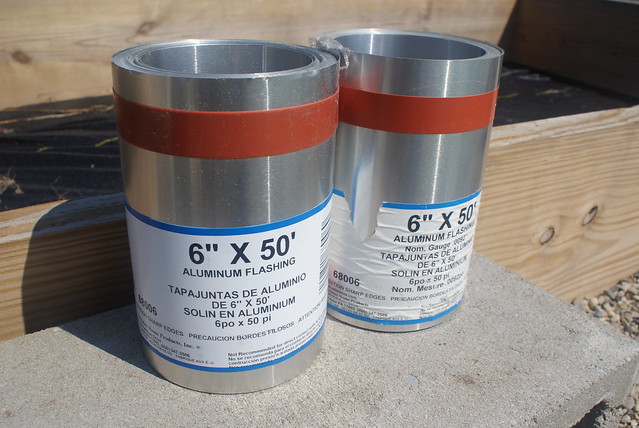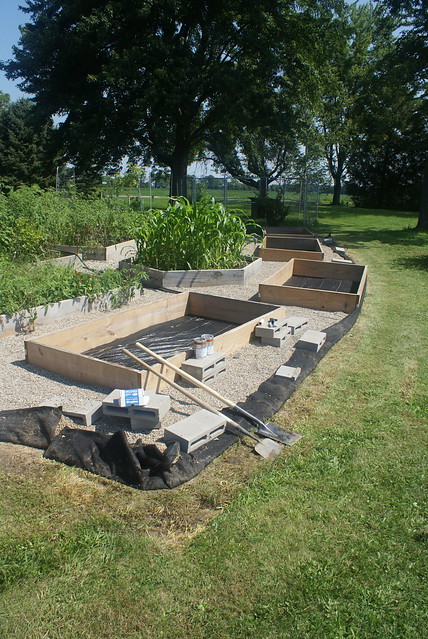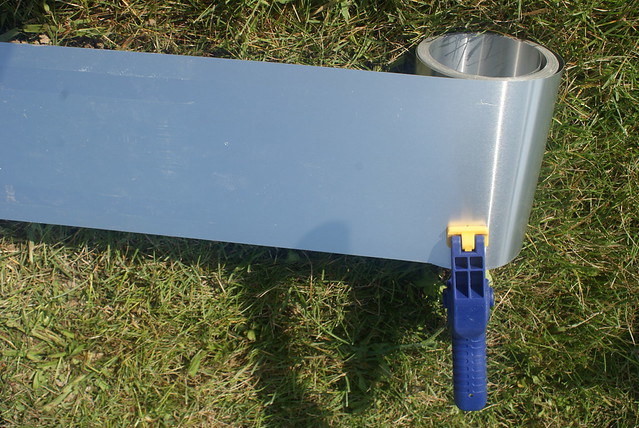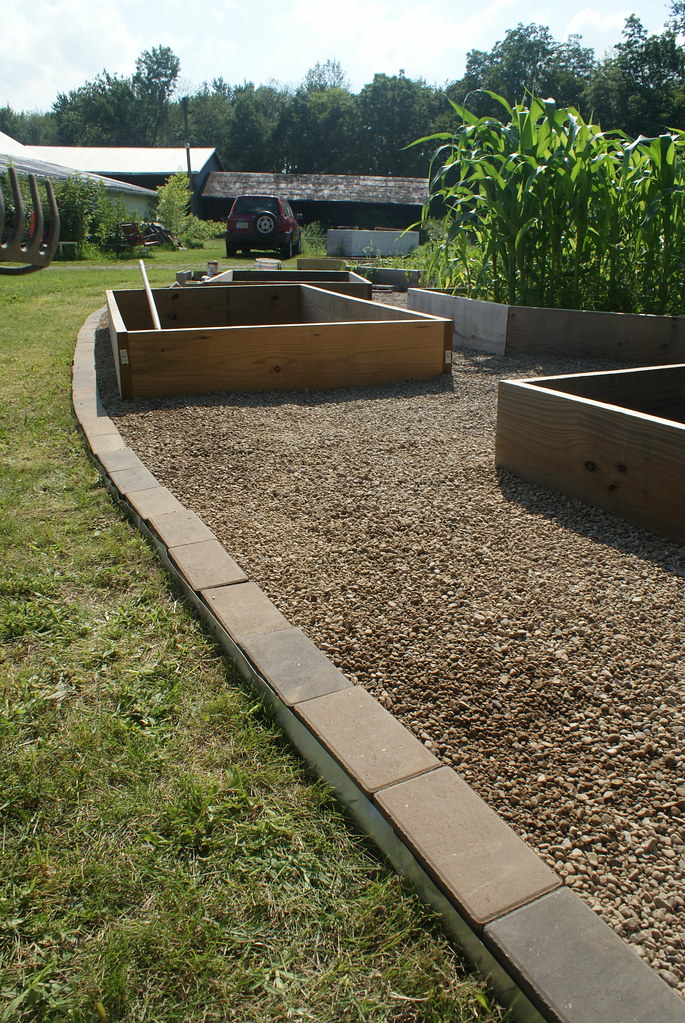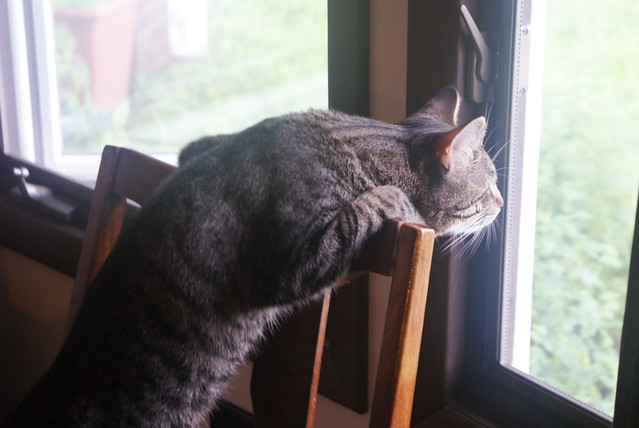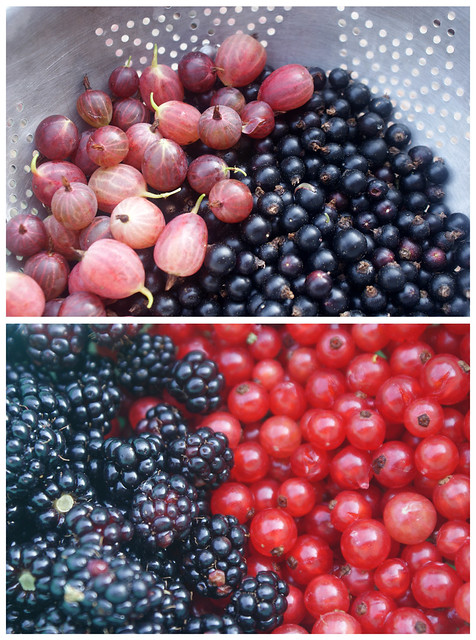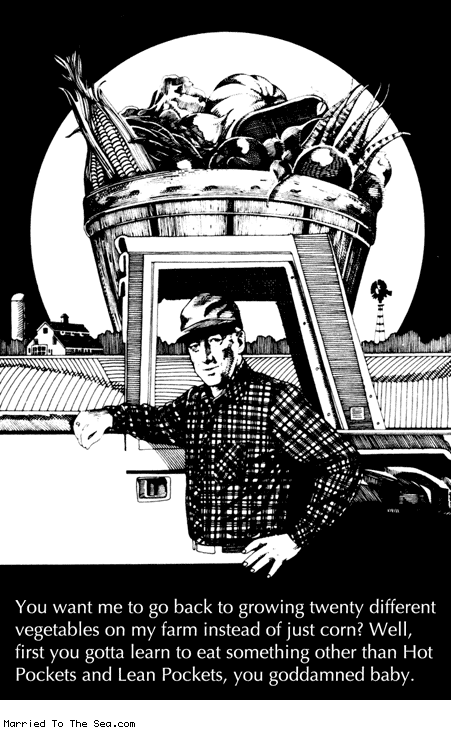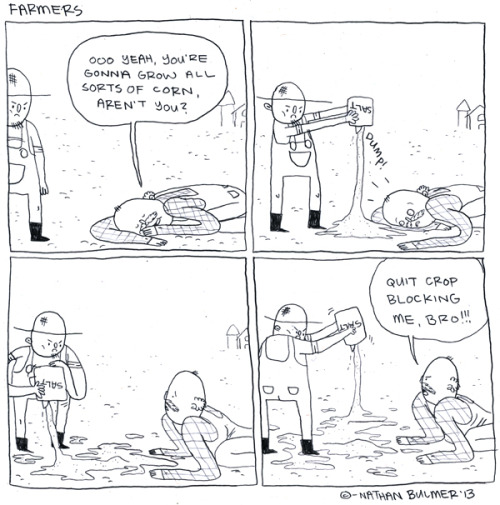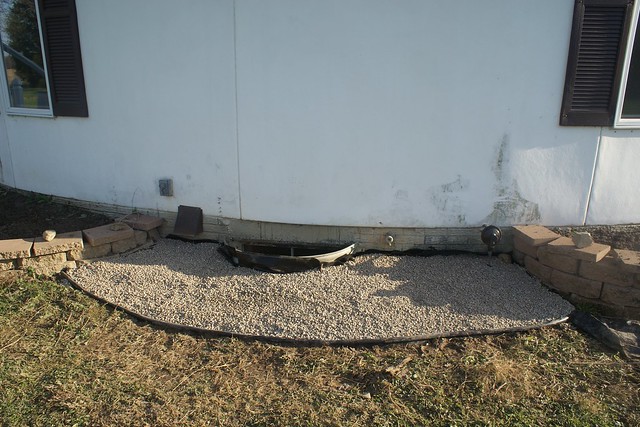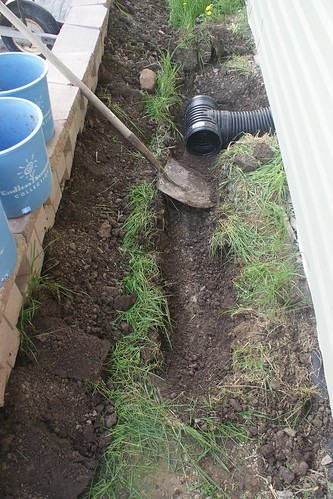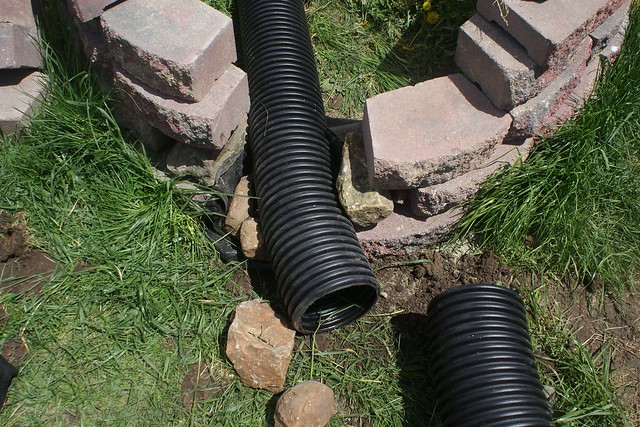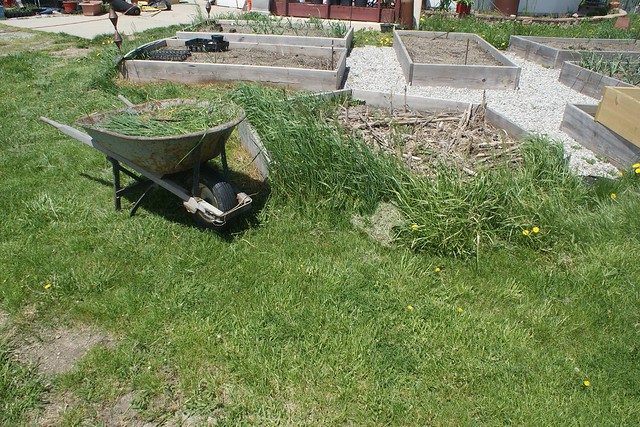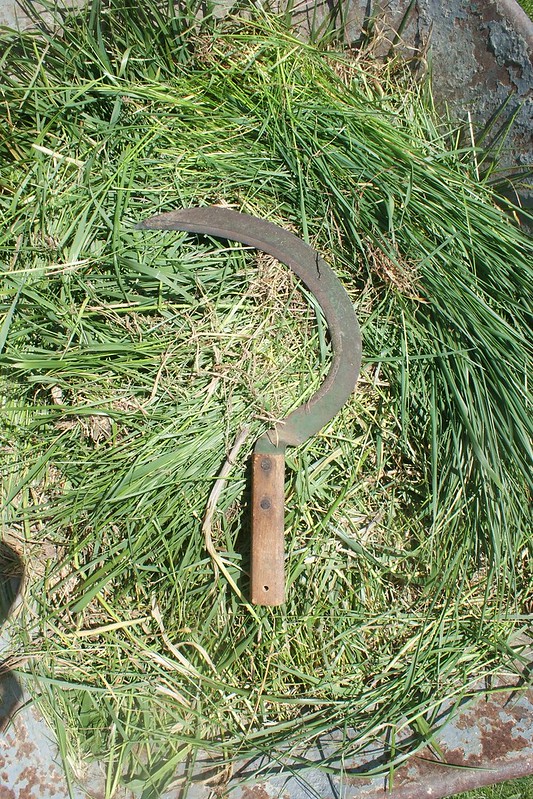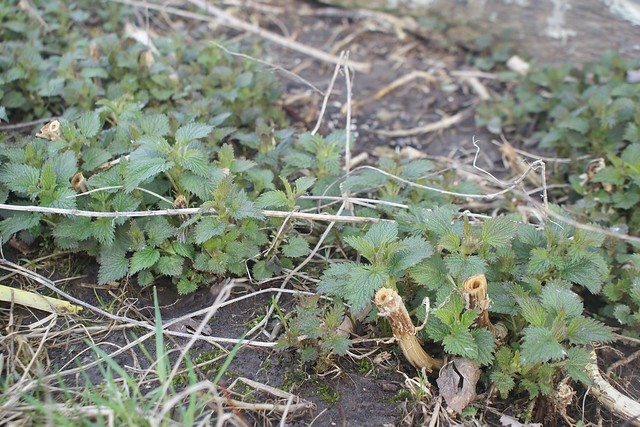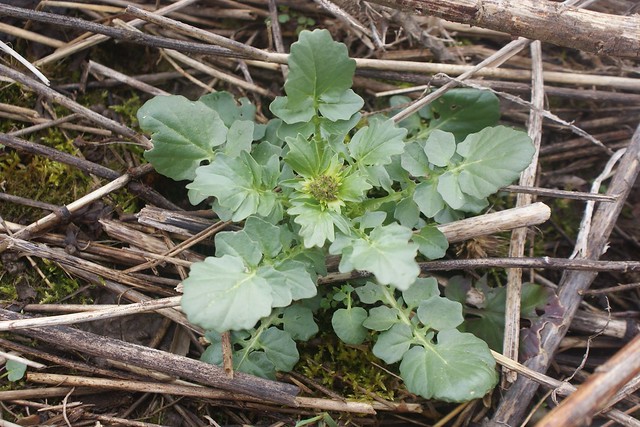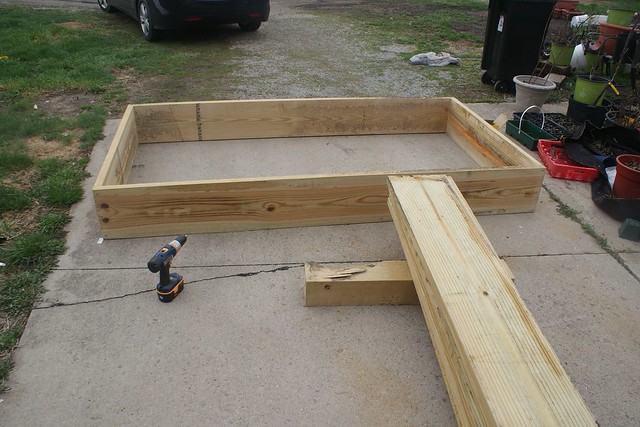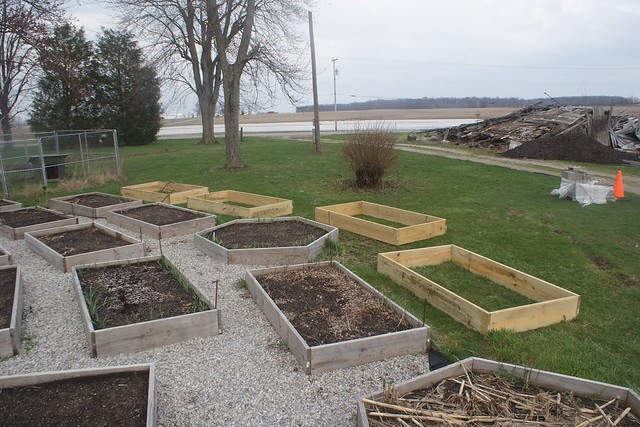Tuesday, December 10, 2013
Concrete Day! (Update)
So the concrete appears to have gone in quite well. They got it in fast while the greenhouse was still relatively warm due to the aforementioned sunshine. Cure time is still a concern, as the sun went down a little after 5pm and the temperature dropped quickly afterwards... but it's all in and it looks pretty level.
I was worried about getting the truck around the back and side of the old white barn to where it could position the chute into the greenhouse door, but both the driver and Chris (my awesome neighbor who does concrete for a living) were total pros and it went off without a hitch. Big thanks to them for making this happen, and for doing it in the dead of winter.
With temperatures being where they are, it'll be a few days before it's good to walk on, and a few weeks before we can put any serious weight on there. That's fine, I'm just glad it's finally in!
Concrete day! Concrete day!
So we've got concrete scheduled to come and get poured in the greenhouse this afternoon (yes, in the middle of December in Ohio).
After several failed attempts previously due to scheduling and weather, this is kind of our last shot... as one of the two local concrete companies has already shut down for the season. I guess nobody likes pouring concrete when it's 20 degrees outside?
We need to get the concrete poured, as we can't get the barrels set up and filled in there without a solid and stable slab to put them on. No barrels, no water. No water, no heat retention... which also means no using the greenhouse until likely next fall... not a very happy proposition around here.
Fortunately, the sun decided to come out today, after a long stretch of dreary cloudiness. I cleaned the snow off the poly panels first thing this morning, and it should be heating up pretty good in there now.
I'm hoping it can catch and hold enough heat to give the concrete a chance to set up properly. Fingers crossed...
Saturday, December 7, 2013
New Baker Creek Seeds Catalog!
Oh, it is a most happy day 'round here when the newest Baker Creek Heirloom Seeds catalog shows up.
When the winter days run short and the snow blows on us, at least we can look at amazing pictures of delicious vegetables.
Wednesday, November 27, 2013
DIY Project: Scrapwood Sawbuck
Put together a pretty solid little folding sawbuck today with a few dollars worth of hardware and some scrap 2x4s. Should make my next chainsaw session out in the woodshed a lot easier/safer.
Thinking of adding a few extra features to it, but we'll see how it works in basic form first.
Found the plans online, here.
Sunday, October 13, 2013
DIY Farm Project: Lawn Edging with Aluminum Gutter Flashing (October Update)
It seems like yesterday I was starting this project, and yet here we are midway through October already? Yeesh. Some bad weather and a flare up of some lower back issues had spared me from the gravel pile for a bit, but this project is on the list of things I wanted to get farther along before winter set in, so I decided to devote what was supposed to be a rainy day of indoor projects to getting some more edging done instead.
I got another 50 feet or so done, curving around back towards the house around the goumi bush and the Korean Stone Pine, around a 90 degree angle and running along the frontside of the two shade beds.
No new technical information to share, the technique is the same as before.
As a few months have gone by since the initial install, I've had a bit of a chance to put this system to the test, i.e. see how well it keeps the grass on the grass and out of the gravel. So far so good. The grass along the edge on the lawn side cleans up nicely with a quick pass of the string trimmer when it gets long, and it's still looking very nice. If I decided to forego the string trimmer at some point, I could still trim the edge by hand, or hit it with the propane torch.
Monday, August 12, 2013
DIY Farm Project: Lawn Edging with Aluminum Gutter Flashing
For the past few years we have spent significant time, energy and materials converting large areas of our overabundant lawnspace over to raised beds for annuals and herbs. Overall, this has been a success and a time-saver, but one of our biggest challenges has been dealing with the edge-space… where garden beds and grassy lawn meet. And our large numbers of beds mean we have a LOT of edge space to deal with.
We've tried a few different approaches, and learned some lessons the hard way. For example:
1. DO NOT have your raised beds directly against your lawn (i.e. no border between them). This is a recipe for a nightmare of upkeep, as the edge is difficult to keep trimmed and most types of grass are only too happy to send runners under the edge of your garden beds and into your garden soil. Nothing is more disheartening than carefully constructing raised beds, only to have them completely colonized by quack grass or Johnsongrass rhizomes within a year's time.
2. Grass and weeds are just as happy (and sometimes happier) growing on the topside of a landscape fabric/gravel combo as it was growing underneath it before you tried to destroy it by piling a bunch of heavy dark stuff on top of it. This arrangement certainly helps, but is no silver bullet.
In a fantasy dreamworld where money is no option, we'd simply purchase bulk quantities of fancypants milled aluminum edging material (which runs about $2.33/foot in it's basic, non-colored form BEFORE freight shpping), laughing while I light a cuban cigar with a burning fifty-dollar bill. Of course, then we'd probably also be paying other people to install it as well… also not happening.
In reality, we needed to devise a lawn edging "system" that met the following requirements:
- Non-degrading, non-toxic, lifetime-ish durability (i.e. not plastic)
- Equally capable of forming graceful curves and sharp edges
- Cheap and easily acquired.
- Relatively easy to prep/install without expensive specialized tools.
- Fireproof (so I can weed with our propane torch).
After a good amount of research, it looked like my material of choice was going to be aluminum gutter flashing. Looking online, I found a lot of instances of people discussing using aluminum gutter flashing as an edging material, but the few pictures I found looked like... well, they looked bad. I do believe there's something to this idea, and hoped that the results could be both practical and nice looking. So we're posting this up here to document how we decided to approach this project in the hope it might be helpful to others.
As with all our "How-To" segments from here at the farm (and most of the stuff we do), I must stress that this technique is essentially experimental. I am NOT saying that I know this is a time-tested method, or that I am an expert of any kind. I come up with stuff like this because I'm cheap and we prefer to DIY things around here whenever possible. If this ends up being a horrible catastrophe, I'll come back and update this with all the specific things I did wrong. That said... onward!
Materials:
- Landscape Fabric (I use DeWit Pro5 5oz weed barrier fabric because it is great).
- Lanscape Fabric staples
- Pea Gravel
- 6" Aluminum flashing.
- Digging spade
- Power drill with 1/8" bit.
- Pop riveter
- GLOVES The flashing is very, very sharp. So sharp. Seriously, wear gloves.
- Thousands of bloodthirsty mosquitoes (not recommended, but we had them)
What I really wanted before starting this project was a nice, pre-sharpened spade, made of good steel with a metal handle. I'll get one eventually, but I was in a pinch this weekend (and the current home collection is mostly scoops and shovels) so I picked one up at Home Depot. I don't expect it to last a lifetime, exactly, but I'll get some good use out of it for what I paid for it.
I started out first thing Saturday morning by sharpening my new spade. Most tools you can buy at Home Depot/Lowes, etc. nowadays are not sharpened at all when you purchase them. I suspect many people think that digging chores are awful at least in part because they're doing it with a dull tool.
I just recently learned what a treat it is to work with a sharp shovel as opposed to a dull one, and as such I am making it a point (no pun intended) to keep my digging tools as sharp as possible from now on. [Link to a good How-To] Ten minutes on the porch with a metal file, and I had both my new shovel and my lawn edger tool with a nice new edge on them.
I started by peeling back and weighting in place the landscape fabric that I had installed last weekend. You can see where it was killing the grass. I then mowed the area on the lowest setting, making sure the grass clippings were flying away from (not into) the garden beds.
I began digging the edge line, straight down to a depth of about 5". This will eventually become the line at which I will install the flashing, and will be the visual break between the bricks and grass... so taking one's time and making sure the curves are smooth and the straight parts are straight is crucial. We didn't have too many straight parts in this part of the garden, otherwise I would have laid them out with some rebar spikes and mason line.
It's important to make sure this line is close enough to the landscape fabric. In most places I simply followed the curve of the edge of the fabric itself, and it turned out fine.
After you've done a decent length, you can go back with your spade and dig down diagonally from the garden side, to meet the vertical cut you just made. You're essentially cutting out a thin wedge of sod/turf.
At this point it's a good idea to go through with a trenching shovel (if you have one) or a trowel and clean out all the loose dirt and debris out of the channel. Make sure the lawn side of the channel is as clean and straight/vertical as possible. From the side, you want it to look like this:

Keeping an even and sufficient depth of this channel is very important, as the flashing installs MUCH easier if you're simply dropping it in a channel that's deep enough, as opposed to trying to push it down into the soil from the top (it's too flimsy for that).
Here's a shot of the channel in progress. After I had dug and cleared a sufficient length, I pulled the fabric down taut into the channel and stapled into the slope. It's okay if it doesn't reach the very bottom.
Then, CAREFULLY unroll your aluminum flashing. I can't emphasize enough how sharp the edges on this stuff are, or how important it is to wear real gloves when you're working with it.
I found that a spring clamp comes in handy if you want to unroll it in portions (it's a bit spring-loaded as it's packaged, and has a tendency to unwind quickly when unfastened).
Install the flashing in the channel. If you've done your digging straight enough and deep enough, this part should be easy. So now the channel should look like the diagram at right. The black is the landscape fabric, and the silver bit is the flashing.
Next, we want to fill the channel with pea gravel. This will be the structural bed on which our bricks will sit.
The trick here is to fill the channel to the point where the brick will stick up past the lip of the aluminum edging by at least 1/2". This will make sure that any foot traffic falls on the sturdy brick (not the flimsy aluminum) and will greatly reduce the chance of anybody getting cut on the metal. Once the bricks are installed and leveled, it should look like the diagram at right:
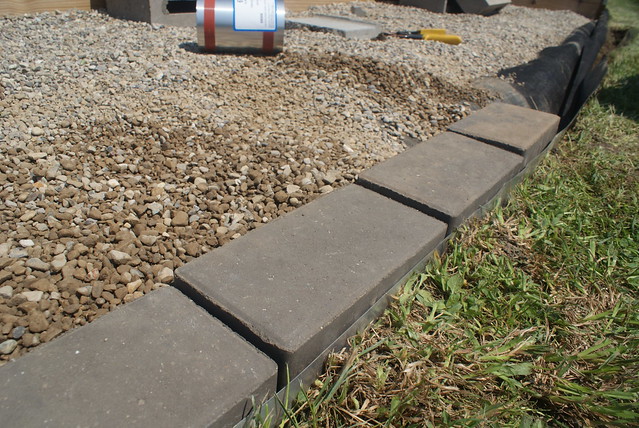
I continued this on around the edge of the garden... digging, clearing, stapling the fabric and placing the flashing, then filling with gravel and placing bricks. I found that it was helpful to carefully bend the flashing in towards the bricks above ground level... this helped minimize any potential gap between the brick edge and the flashing. If a brick is too low or high, you can level it by adjusting the amount of gravel underneath. After the bricks were in, I filled the garden bed walkways with gravel right up to the edge of the bricks.
We've got a lot of edging left to do, but I'm pretty comfortable with the process now, and now that I've got the hang of things, it's going pretty quickly. Here's a shot of the long curved edge at the end of the day. I'm pretty happy with how it looks, and I'm hoping that it will hold up, and that the ability to weed along the edge with the propane torch will be a real timesaver in the future. I'll update the blog as we continue to install the edging around our raised bed spaces. As always, we welcome feedback, comments, hints, suggestions, or dire warnings. Or, drop us a line if you found this helpful!
Sunday, August 11, 2013
Free Apples!
While we share their dismay that so many of their apples got blown off their trees recently, we want to extend many many thanks to Cherry Hawk Farm in Marysville for letting us (and other) come and nab about 20 gallons worth of free dropped apples this morning. As our apple trees are much smaller than theirs (and mostly not bearing fruit yet), it's really neat to have a bunch of apples to work with.
I sense applesauce, pie filling, and some dehydrator action in the near future!
I sense applesauce, pie filling, and some dehydrator action in the near future!
Saturday, July 6, 2013
Rabbits, rabbits everywhere...
If we just gave up all this gardening nonsense and dubbed ourselves a wild rabbit sanctuary, we would already have achieved success on a massive scale. Spied a real wee'un today nibbling around the edge of the gardens. He's no threat to our raised beds yet, I don't even think he's big enough to hop inside.
At any given time, one can walk out our back door and immediately lay eyes on one (or more likely several) rabbits. Sure, they munch a bit in the garden (and are absolute hell on young trees in the winter), but they're cute as you'd like. Also, it gives our cat something to do. He's usually glued to the windows watching BunTV (whenever he's not passed out on the floor in an odd position, that is).
Sunday, June 30, 2013
We Have Many Berries, but I Have Zero Trucks to Give...
We've been getting small but increasing harvests of berries the past few weeks, but I think berry season peaked today. We got another huge bunch of black currants, and the red currants are finally ripe. We finally got a small quantity of gooseberries (not just the one or two we'd managed to snag previously), and the invasive (as in, it's breaking into our garage) but productive blackberry bushes I (foolishly) planted alongside the back of the house have begun to bear.
After planting and waiting and planting and waiting and dealing with setbacks and replanting and waiting, It's so nice to actually have some plants that are of bearing age. It's nice to know we're that one small step closer to having a beautiful and edible Wonka-esque wonderland just outside our front door.
Now, let's roll that beautiful berry footage...
Helping my sister move into her new place down in Columbus and a lot of rain on Sunday made for a pretty low-key weekend all-in-all. I got some renovation work done in the basement AND OH MY GOD WE FINALLY SOLD THE TRUCK. After having approximately one hundred thousand conversations with interested parties (the failure of which ultimately boils down to the fact that a) the truck is not brand new and not guaranteed to run perfectly forever, and b) it cost more than $12), I finally sold the thing to a guy who lives down the road and will hopefully love her for what she is and forgive her for what she is not.
Ah, how shiny she looked when I first got her! She took me a lot of places. We had some good times, and some not so good times. Lord knows I cursed at her. And now she's with somebody else. Goodnight, sweet Scarlet! Can't say I'll miss having you around.
After planting and waiting and planting and waiting and dealing with setbacks and replanting and waiting, It's so nice to actually have some plants that are of bearing age. It's nice to know we're that one small step closer to having a beautiful and edible Wonka-esque wonderland just outside our front door.
Now, let's roll that beautiful berry footage...
Helping my sister move into her new place down in Columbus and a lot of rain on Sunday made for a pretty low-key weekend all-in-all. I got some renovation work done in the basement AND OH MY GOD WE FINALLY SOLD THE TRUCK. After having approximately one hundred thousand conversations with interested parties (the failure of which ultimately boils down to the fact that a) the truck is not brand new and not guaranteed to run perfectly forever, and b) it cost more than $12), I finally sold the thing to a guy who lives down the road and will hopefully love her for what she is and forgive her for what she is not.
Ah, how shiny she looked when I first got her! She took me a lot of places. We had some good times, and some not so good times. Lord knows I cursed at her. And now she's with somebody else. Goodnight, sweet Scarlet! Can't say I'll miss having you around.
Tuesday, June 4, 2013
And the internets abound with farm-related humor this week, it seems. From the Central-Ohio based (yes, even our comics are local) Married To the Sea. There's truth in them thar hills...
Monday, June 3, 2013
Crop blocked....
More from Nathan Bulmer at his amazing daily comics blog Eat More Bikes.
Hardly all farm-themed, but the guy makes me laugh almost every single day.
Saturday, June 1, 2013
Pardon us while we catch up....
Please excuse the brief intermission. We took a week off to go tromp around sunny California for a week, and are madly playing catch up here on the farm (the weeds and grass, it seems, did not take a vacation).
Back soon!
Sunday, May 5, 2013
Surgery recovery, loose ends, and Earth Tubes!
Over the last few weeks I've been focusing on some "loose ends" type projects around the farm while recovering from a minor surgery to repair an umbilical hernia. My strength, physical ability, and energy level are pretty much back up to where they were beforehand, but for a while there I was putting around on impulse power.
So this is going to be a long post, fair warning!
I spent the better part of a weekend a few weeks ago applying landscape fabric and pea gravel to the gap areas between sections of our circumn-housal (I totally just made that word up) raised beds. Due to their shape and location they are notoriously hard to mow/trim, and as a result these areas annually became a nightmare tangle of odd and menacing volunteer plants (with a common itchy thread of poison ivy woven throughout). So this year, while everything was still "down and brown" from winter, I decided to get proactive about it.
The results look pretty darn good, and will hopefully cut down on the amount of poison ivy we find trying to grow up the side of the house this fall (those would be the dark places along the house wall).
We spent a goodly amount of time last weekend working on the barn wreckage and putting up some more insulation panels in the greenhouse. We are approaching the time of year when it's really only comfortable in the greenhouse in the morning before the sun really gets going, and in the evening after it's gone down. So we'll be working in there on mornings and rainy days, and picking up whatever didn't get done in the fall. Hopefully we can get it 100% shored up inside for this winter, where we can do a real test of what will and won't grow in there during the icy months.
This weekend found us working to install the "earth tubes" passive ventilation system on the greenhouse. I had the idea for this while sealing up some small air leaks around the interior of the greenhouse, near the floor. I noticed that the greenhouse was pulling cool air in through these small airspaces, presumably as a result of the heated air being pushed out the two gable vents near the top of the side walls.
So I began planning for a system that would take better advantage of this tendency, in a way that would passively provide some measure of cool air flowing through the greenhouse during periods of warmer weather. It is essentially a set of two tubes that are buried beneath the entire earth mass of the raised bed along the shady north-facing side, and enter the greenhouse through the floor.
As convection pushes the hot air out the gable vents at the ends of the greenhouse, it should pull air through the tubes, cooling it as it passes beneath all the shaded soil (we may add a small solar-powered inline fan to increase draw through the tubes if needed).

In the winter we could limit or stop the air flow from within the greenhouse, to prevent pulling too much cold air in (buried no deeper than it is, the soil will be much less likely to provide any appreciable warming action on the cold air in winter).
I had never heard of Earth Tubes before, but in researching my newfound idea I learned that a similar system is frequently put into use in Earthships and other more holistically-designed homes.
In those circumstances, the systems are buried deep enough to provide cooling in the summer AND warming in the winter, but for our purposes we've got warming pretty much covered from the passive solar angle.
I'm still not sure to what extent it will work or how much air it will pull, but I'm pretty sure that it will provide some benefit, and it was relatively inexpensive to install (needing just a big-ass roll of HDPE drainage tubing, pictured above) and requires no major modifications to the greenhouse itself.
So I started digging! First, one of two holes that burrows just under the north wall of the greenhouse.
Here's the tube sticking up inside. Once we finish putting up the second layer of insulation and the radiant heat barrier, we'll trim the pipe off closer to the floor and affix it to the wall somehow.
I kept digging a trench, slowly grading up from the low spot where the tube enters the building. By the time it met the farthest point of the raised bed, it needed to be at ground level to avoid taking in water during rains. I took down a few sections of the raised bed, and got the tube situated. I cut it off long, unsure of exactly how much tube I wanted sticking out. I can trim it later.
So this is going to be a long post, fair warning!
I spent the better part of a weekend a few weeks ago applying landscape fabric and pea gravel to the gap areas between sections of our circumn-housal (I totally just made that word up) raised beds. Due to their shape and location they are notoriously hard to mow/trim, and as a result these areas annually became a nightmare tangle of odd and menacing volunteer plants (with a common itchy thread of poison ivy woven throughout). So this year, while everything was still "down and brown" from winter, I decided to get proactive about it.
The results look pretty darn good, and will hopefully cut down on the amount of poison ivy we find trying to grow up the side of the house this fall (those would be the dark places along the house wall).
We spent a goodly amount of time last weekend working on the barn wreckage and putting up some more insulation panels in the greenhouse. We are approaching the time of year when it's really only comfortable in the greenhouse in the morning before the sun really gets going, and in the evening after it's gone down. So we'll be working in there on mornings and rainy days, and picking up whatever didn't get done in the fall. Hopefully we can get it 100% shored up inside for this winter, where we can do a real test of what will and won't grow in there during the icy months.
This weekend found us working to install the "earth tubes" passive ventilation system on the greenhouse. I had the idea for this while sealing up some small air leaks around the interior of the greenhouse, near the floor. I noticed that the greenhouse was pulling cool air in through these small airspaces, presumably as a result of the heated air being pushed out the two gable vents near the top of the side walls.
So I began planning for a system that would take better advantage of this tendency, in a way that would passively provide some measure of cool air flowing through the greenhouse during periods of warmer weather. It is essentially a set of two tubes that are buried beneath the entire earth mass of the raised bed along the shady north-facing side, and enter the greenhouse through the floor.
As convection pushes the hot air out the gable vents at the ends of the greenhouse, it should pull air through the tubes, cooling it as it passes beneath all the shaded soil (we may add a small solar-powered inline fan to increase draw through the tubes if needed).

In the winter we could limit or stop the air flow from within the greenhouse, to prevent pulling too much cold air in (buried no deeper than it is, the soil will be much less likely to provide any appreciable warming action on the cold air in winter).
I had never heard of Earth Tubes before, but in researching my newfound idea I learned that a similar system is frequently put into use in Earthships and other more holistically-designed homes.
In those circumstances, the systems are buried deep enough to provide cooling in the summer AND warming in the winter, but for our purposes we've got warming pretty much covered from the passive solar angle.
I'm still not sure to what extent it will work or how much air it will pull, but I'm pretty sure that it will provide some benefit, and it was relatively inexpensive to install (needing just a big-ass roll of HDPE drainage tubing, pictured above) and requires no major modifications to the greenhouse itself.
So I started digging! First, one of two holes that burrows just under the north wall of the greenhouse.
Here's the tube sticking up inside. Once we finish putting up the second layer of insulation and the radiant heat barrier, we'll trim the pipe off closer to the floor and affix it to the wall somehow.
Some creative stone work to fill in some gaps and some retaining wall re-assembly, and we had ourselves an installed tube! I need to find or fabricate some form of grate cap for the end to keep my new air tube from becoming a high-traffic tunnel for critters (especially in the colder months when a warm building is oh-so enticing).
I am encouraged thus far, as the building is sucking air in through the hole around the tube at a noticeable rate. I'm hoping it will do the same through the tubes once I get that hole back-filled and sealed.
I also thought it would be a good time to dig the post-holes on either end of the west-facing door that will serve as the structural supports for our forthcoming trellis/pergola/awning thing (I didn't want to have to dig the dirt back out of the beds once I'd filled it in).
The trellis/pergola/awning thing will not only look neat and provide some shade over the west doorway, but will also provide a venue for climbing vining plants like grapes or wisteria. It will also give me something solid to latch the door to when it's open so it's not blowing shut all the cussing time.
Spent the rest of the day preparing to extend our annual raised bed area, chopping back quack grass from around (and unfortunately, within) some of our beds who have a side that touches lawn. Important lesson here when it comes to raised beds.... always make sure you have a border of grass-suppressant (lanscape fabric, gravel, something) all the way around your beds... otherwise the grass will just hop under the bed walls and go to town in the soil inside. If I had a dollar for every worming little white root I fished out of the dirt today... ugh.
This did mean that I got to make some good use of my new hand sickle today... old but practically brand new, I picked it up at the local flea market for $2.50. Sharp enough to dig deep into the wood of the raised bed when I miscalculated my swing. Vanquished a lot of grass out today with that thing....
Friday, May 3, 2013
Apples and pears in bloom!
Stepped out this morning to find several of our apple trees (Blushing Golden and a few crab apples) and some asian pears in full spectacular bloom.
Sunday, April 14, 2013
Spring chores and planting out the nut orchard/woodlot....
Did some general cleanup around the farm first thing this morning, while I waited for our neighbor up the road to swing by with her parents and take some barn wood for a chicken coop she's building. I cleaned the old canes out of the stinging nettle patches. They're just starting to poke out their first growth. Can't wait to start harvesting for cooking/tea. I'm sure not too many people enjoy cultivating them as much as we do. We cherish them as a no-fuss, no-maintenance, delicious and nutrient-dense addition to our spring diet.
And now that spring is arriving, some of our earliest fruit trees are starting to bloom. Our Galaxy Peach tree by the driveway is about half-bloomed, and I even spied some honeybees attending to the flowers today. Not much besides our maple trees are blooming out here yet, I imagine they are taking what they can get... soon enough there will be an endless bounty for them.
Our neighbor and her folks showed up around 10am, and spent the better part of three hours selectively pulling wood off the barn wreckage. They moved more than they took, and you can hardly tell there's any missing.
I spent the better part of the day out in the field, planting chestnut and black locust seedlings. This is the perfect time of year for such a task, before the field becomes an impenetrable riot of switchgrass and field weeds, and the clouds of mosquitoes swell to semi-biblical proportions even during the hottest part of the day. Today there was only the crunch of last year's brittle growth under foot.
Having received approximately no human attention for the better part of fifteen or twenty years, the soil in the field has benefited from the constant cycle of growth and decay playing out along it's surface. It is still somewhat clay-heavy in spots, but driving a spade into the ground most anywhere produces earth that is dark and crumbly and absolutely loaded with worms and their casings. Still, I'm hedging my bets by planting the chestnuts in the best-draining areas only.
About half of the chestnuts I bought are only 1-2 year old seedlings, and are looking a bit wimpy to plant out in the field at their small size. I may pot them up near the house and grow them a bit before transplanting them.
Total tally for the day was a total of seventeen trees planted... six Silverleaf Chestnuts and eleven Black Locust seedlings. I took special care with the chestnuts, clearing a large three-foot-square area and covering it with landscaping fabric and mulch. Every tree got a Tubex tree tube, to speed growth and because the rabbits and deer are always hungry.
Spent the last portion of the day removing the failed grape trellis that runs behind the house. The grapes (which are always described as being carefree and easy to grow) languished since day one... I think they were in soil that was too heavy, with not enough water and too many insects (Japanese Beetles especially) that enjoyed munching on them. A few of the larger specimens might end up in the plant hospital depending on how they bud out, but most aren't even worth saving.
We're thinking that when we try a mass-planting of grapes again, we're going to plan it out better first this time... finding the right grapes and putting them in the right location. Novel idea, huh? Ah well, this is how we learn...
Saturday, April 13, 2013
Chestnut orchard layout, even more raised beds, and accidental garlic...
After coffee and a few pieces of Leah's excellent banana bread, I pulled on my muck boots and waded out into our very skooshy farm. We've had significant amounts of rain over the past few days (finally!) and the soil in the field is pretty waterlogged.
I drove some T-posts to mark out the locations of soon-to-be-planted trees, along the better-drained and less consistently marshy eastern edge of our fallow field. This year I'll be putting in between ten and twenty blight-resistant chestnut trees (about five different varieties), interplanted with black locust seedlings. The goal is to begin converting this portion of our field towards a more productive and diverse forest area that will one day provide us with food and timber.
All the plants in the area are loving the moisture and have seemingly sprung to life overnight. The grass which looked patchy and very dormant as recently as a week ago now looks like it might need mowing soon (ugh).
We've been reading Gene Logsdon's Living at Nature's Pace: Farming and the American Dream this month for our Meetup group's book club, and it's got me reminding myself of the importance of being constantly aware of and an expert on one's own place, down to every seemingly mundane detail.
So amongst the moss and wet and mouldering remnants of last year's growth (and the ever more ubiquitous spiked rosettes of teasel), I spotted a few plants I was unfamiliar with:
After some research, I'm pretty sure this is some kind of cress. The closest ID I could find was Early Winter Cress, but I'm still not 100% sure. I'd like to be sure before I try nibbling on it. But I want to. Because I love cress.
Leah also noticed some type of volunteer sedum growing down by the swale on one of the piles where I've dumped potentially live plant material that I didn't want gaining a foothold in our compost piles. We've found some similar looking plants on Google image search, but are also finding them identified (potentially mis-identified) as various different species of sedum.
We're discussing rescuing it from the unruly riot that is our woods edge down by the swale and giving it a more dignified home in a pot up near the house. It certainly is lovely looking.
We've been planning to expand our existing Zone 1 raised bed area that we use for more intensive cultivation of annuals along the southeast side of the house. We've had the lumber sitting around for a while, but I just got around to drilling and screwing the beds together today.
I assembled four 4'x8'x12" beds, and Leah and I tried some different placements to see what looked best. We're gonna let them sit for a bit and see how it looks from different angles before we extend the fabric/gravel and formally install them.
If you look closely in the picture above, you can see little sprigs of green around the interior edge of our raised beds... that's our garlic, dutifully performing it's duties as one of spring's tastiest ephemerals.
Speaking of garlic, we've had some garlic bulbs that we missed in last fall's "hasty harvest" sprout up bunches of greens at the same time as their more fastidiously harvested/stored/replanted brethren, and this has me thinking....
Leah reminded me that some people just leave the garlic in the soil year-round rather than harvesting it in summer and then replanting later in fall. I'm not sure what the advantages/disadvantages to this method, but I carefully dug up, separated and replanted our "forgotten" shoots at wider intervals. We'll see how they fare in relation to the cloves we planted in the fall. A garlic experiment! For science!
I drove some T-posts to mark out the locations of soon-to-be-planted trees, along the better-drained and less consistently marshy eastern edge of our fallow field. This year I'll be putting in between ten and twenty blight-resistant chestnut trees (about five different varieties), interplanted with black locust seedlings. The goal is to begin converting this portion of our field towards a more productive and diverse forest area that will one day provide us with food and timber.
All the plants in the area are loving the moisture and have seemingly sprung to life overnight. The grass which looked patchy and very dormant as recently as a week ago now looks like it might need mowing soon (ugh).
We've been reading Gene Logsdon's Living at Nature's Pace: Farming and the American Dream this month for our Meetup group's book club, and it's got me reminding myself of the importance of being constantly aware of and an expert on one's own place, down to every seemingly mundane detail.
So amongst the moss and wet and mouldering remnants of last year's growth (and the ever more ubiquitous spiked rosettes of teasel), I spotted a few plants I was unfamiliar with:
After some research, I'm pretty sure this is some kind of cress. The closest ID I could find was Early Winter Cress, but I'm still not 100% sure. I'd like to be sure before I try nibbling on it. But I want to. Because I love cress.
Leah also noticed some type of volunteer sedum growing down by the swale on one of the piles where I've dumped potentially live plant material that I didn't want gaining a foothold in our compost piles. We've found some similar looking plants on Google image search, but are also finding them identified (potentially mis-identified) as various different species of sedum.
We're discussing rescuing it from the unruly riot that is our woods edge down by the swale and giving it a more dignified home in a pot up near the house. It certainly is lovely looking.
We've been planning to expand our existing Zone 1 raised bed area that we use for more intensive cultivation of annuals along the southeast side of the house. We've had the lumber sitting around for a while, but I just got around to drilling and screwing the beds together today.
I assembled four 4'x8'x12" beds, and Leah and I tried some different placements to see what looked best. We're gonna let them sit for a bit and see how it looks from different angles before we extend the fabric/gravel and formally install them.
If you look closely in the picture above, you can see little sprigs of green around the interior edge of our raised beds... that's our garlic, dutifully performing it's duties as one of spring's tastiest ephemerals.
Speaking of garlic, we've had some garlic bulbs that we missed in last fall's "hasty harvest" sprout up bunches of greens at the same time as their more fastidiously harvested/stored/replanted brethren, and this has me thinking....
Leah reminded me that some people just leave the garlic in the soil year-round rather than harvesting it in summer and then replanting later in fall. I'm not sure what the advantages/disadvantages to this method, but I carefully dug up, separated and replanted our "forgotten" shoots at wider intervals. We'll see how they fare in relation to the cloves we planted in the fall. A garlic experiment! For science!
Subscribe to:
Posts (Atom)




